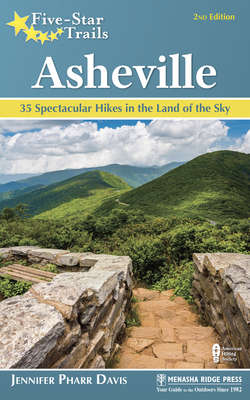Читать книгу Five-Star Trails: Asheville - Jennifer Pharr Davis - Страница 16
На сайте Литреса книга снята с продажи.
Оглавление3 Haw Creek Overlook
A VIEW OF THE SWANNANOA RIVER BASIN FROM HAW CREEK OVERLOOK
SCENERY:
TRAIL CONDITION:
CHILDREN:
DIFFICULTY:
SOLITUDE:
GPS TRAILHEAD COORDINATES: N35° 35.556' W82° 28.856'
DISTANCE & CONFIGURATION: 4.8-mile out-and-back
HIKING TIME: 2.5 hours
HIGHLIGHTS: Exposed rock overlooking Haw Creek Valley
ELEVATION: 2,260' at trailhead, 2,830' at Haw Creek Overlook
ACCESS: Free and always open; vehicle access to the Folk Art Center via the Blue Ridge Parkway is also open year-round.
MAPS: USGS Oteen
FACILITIES: Restrooms, water fountains, and picnic benches at the Folk Art Center
WHEELCHAIR ACCESS: Yes, at the Folk Art Center
COMMENTS: This hike offers a great view of Haw Creek Valley and Town Mountain. The Folk Art Center, with its museum and store filled with Appalachian crafts, is a worthwhile stop in itself, as further described in “Nearby Attractions,” below.
CONTACTS: Blue Ridge Parkway: 828-298-0398, nps.gov/blri; Mountains-to-Sea Trail: mountainstosea.org
Overview
Just off the Blue Ridge Parkway, this out-and-back Mountains-to-Sea Trail (MST) section hike starts at the Folk Art Center, which serves as a convenient and easily accessible trailhead. From the Folk Art Center, you will follow the MST east and steadily uphill. The reward for hiking up the ascent is a rock overlook with beautiful views of Haw Creek Valley, Town Mountain, and East Asheville—and a downhill trek back to the trailhead.
Route Details
Your 4.8-mile hike proceeds close to the Blue Ridge Parkway, but the road goes unnoticed. You will be hiking inside the dense hardwood forest and among pockets of mountain laurel that line the trail. In fact, the location by the parkway spells good news for hikers: Although much of the scenic byway is closed from late November to March due to winter weather, a small piece of it, off US 70, is open year-round. That allows the Folk Art Center to operate through four seasons, and it also means that this trailhead is always accessible. Many East Asheville residents will hike this stretch of trail before or after work because of its proximity to nearby businesses and neighborhoods.
To begin the hike, locate the informational kiosk in front of the Folk Art Center. At the kiosk you will leave the paved sidewalk and walk north on a granular path. This path is part of a short nature walk that surrounds the Folk Art Center and coincides with the MST. As your route is a small part of the 1,175-mile MST, you will want to look ahead to spot a white circle that marks the long-distance trail; that white blaze tells you that you are headed in the right direction.
After passing the Folk Art Center on your left, the MST ascends a small hill. At 0.2 mile it veers off to the right. Because the granular nature walk is so well defined and the MST looks like a dirt rabbit trail, hikers will often miss this turnoff. Be sure to keep an eye out for the double blaze—two offset white circles—that mark the change in direction. You will want to be on the MST.
Immediately after departing the nature walk and veering onto the MST, you will cross an overpass that spans the width of Rice-ville Road. Then you will start a moderate uphill climb. Because of its location near the Folk Art Center, this ascent features several wooden benches that beckon you to stop and catch your breath. Take advantage of the rest stops, but do not expect this luxury on subsequent climbs.
After hiking 1 mile, you will reach the trail’s intersection with the Blue Ridge Parkway. Follow the trail as it crosses a small wooden footbridge before delving back into the woods. There, hikers will leave behind the tourists stretching their legs near the Folk Art Center and find a secluded trail that travels among hickory, locust, oak, and poplar trees.
During late spring and summer, wildflowers, such as milkweed and flowering raspberry, will appear on the side of the trail. Galax and squaw root also line the route. Squawroot, otherwise known as bear corn, grows near the base of oak trees and looks like brown pinecones or corncobs coming up from the ground. It does not contain any chlorophyll and receives its nutrients by parasitically feeding off the roots of an oak tree.
Nearly 0.5 mile after crossing the Blue Ridge Parkway, the hike will transition from a gradual climb to a strenuous uphill crawl. After another quarter mile, the trail levels out and provides you a moment to catch your breath before you once again begin a steep climb to Haw Creek Overlook.
Haw Creek Overlook is not marked along the MST and goes unnoticed to unobservant hikers. After leaving the level ridge and beginning what will be your final uphill climb, look closely for a dirt path that is directly opposite a white-blazed oak tree on your right.
Follow the side trail 50 feet downhill to a rock overlook. From this viewpoint, you can see the houses and farmland of Haw Creek Valley, and you can pick out Beaucatcher Mountain near downtown Asheville. To the right of Beaucatcher Mountain, you can trace the ridge of Town Mountain north to its connection with the Blue Ridge Parkway.
